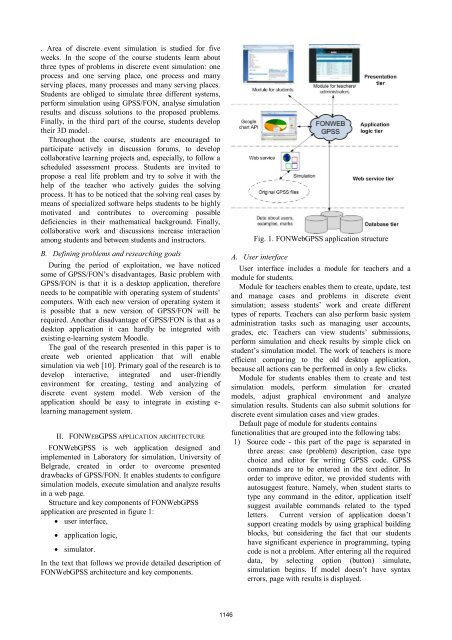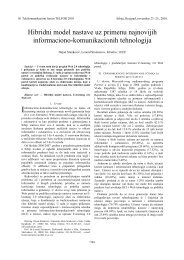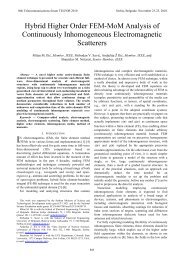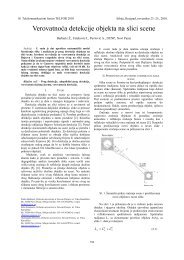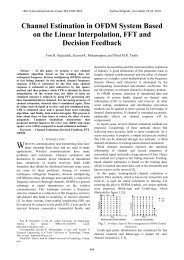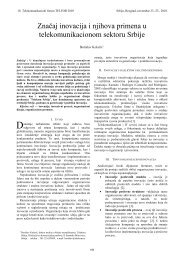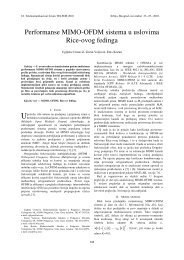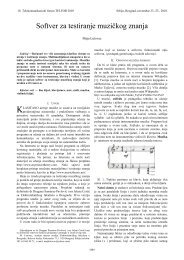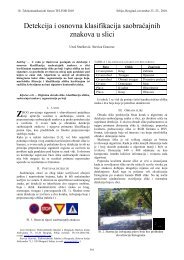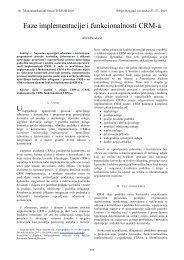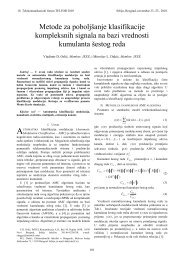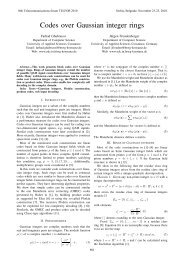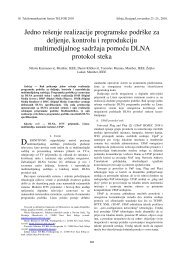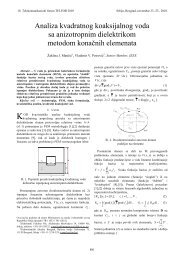TELFOR 2006 - 18. telekomunikacioni forum TELFOR 2010 - Telfor
TELFOR 2006 - 18. telekomunikacioni forum TELFOR 2010 - Telfor
TELFOR 2006 - 18. telekomunikacioni forum TELFOR 2010 - Telfor
You also want an ePaper? Increase the reach of your titles
YUMPU automatically turns print PDFs into web optimized ePapers that Google loves.
. Area of discrete event simulation is studied for five<br />
weeks. In the scope of the course students learn about<br />
three types of problems in discrete event simulation: one<br />
process and one serving place, one process and many<br />
serving places, many processes and many serving places.<br />
Students are obliged to simulate three different systems,<br />
perform simulation using GPSS/FON, analyse simulation<br />
results and discuss solutions to the proposed problems.<br />
Finally, in the third part of the course, students develop<br />
their 3D model.<br />
Throughout the course, students are encouraged to<br />
participate actively in discussion <strong>forum</strong>s, to develop<br />
collaborative learning projects and, especially, to follow a<br />
scheduled assessment process. Students are invited to<br />
propose a real life problem and try to solve it with the<br />
help of the teacher who actively guides the solving<br />
process. It has to be noticed that the solving real cases by<br />
means of specialized software helps students to be highly<br />
motivated and contributes to overcoming possible<br />
deficiencies in their mathematical background. Finally,<br />
collaborative work and discussions increase interaction<br />
among students and between students and instructors.<br />
B. Defining problems and researching goals<br />
During the period of exploitation, we have noticed<br />
problem with<br />
GPSS/FON is that it is a desktop application, therefore<br />
<br />
computers. With each new version of operating system it<br />
is possible that a new version of GPSS/FON will be<br />
required. Another disadvantage of GPSS/FON is that as a<br />
desktop application it can hardly be integrated with<br />
existing e-learning system Moodle.<br />
The goal of the research presented in this paper is to<br />
create web oriented application that will enable<br />
simulation via web [10]. Primary goal of the research is to<br />
develop interactive, integrated and user-friendly<br />
environment for creating, testing and analyzing of<br />
discrete event system model. Web version of the<br />
application should be easy to integrate in existing elearning<br />
management system.<br />
II. FONWEBGPSS APPLICATION ARCHITECTURE<br />
FONWebGPSS is web application designed and<br />
implemented in Laboratory for simulation, University of<br />
Belgrade, created in order to overcome presented<br />
drawbacks of GPSS/FON. It enables students to configure<br />
simulation models, execute simulation and analyze results<br />
in a web page.<br />
Structure and key components of FONWebGPSS<br />
application are presented in figure 1:<br />
user interface,<br />
application logic,<br />
simulator.<br />
In the text that follows we provide detailed description of<br />
FONWebGPSS architecture and key components.<br />
1146<br />
Fig. 1. FONWebGPSS application structure<br />
A. User interface<br />
User interface includes a module for teachers and a<br />
module for students.<br />
Module for teachers enables them to create, update, test<br />
and manage cases and problems in discrete event<br />
<br />
types of reports. Teachers can also perform basic system<br />
administration tasks such as managing user accounts,<br />
<br />
perform simulation and check results by simple click on<br />
<br />
efficient comparing to the old desktop application,<br />
because all actions can be performed in only a few clicks.<br />
Module for students enables them to create and test<br />
simulation models, perform simulation for created<br />
models, adjust graphical environment and analyze<br />
simulation results. Students can also submit solutions for<br />
discrete event simulation cases and view grades.<br />
Default page of module for students contains<br />
functionalities that are grouped into the following tabs:<br />
1) Source code - this part of the page is separated in<br />
three areas: case (problem) description, case type<br />
choice and editor for writing GPSS code. GPSS<br />
commands are to be entered in the text editor. In<br />
order to improve editor, we provided students with<br />
autosuggest feature. Namely, when student starts to<br />
type any command in the editor, application itself<br />
suggest available commands related to the typed<br />
<br />
support creating models by using graphical building<br />
blocks, but considering the fact that our students<br />
have significant experience in programming, typing<br />
code is not a problem. After entering all the required<br />
data, by selecting option (button) simulate,<br />
simulat <br />
errors, page with results is displayed.


